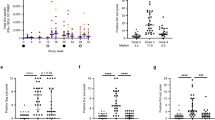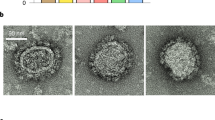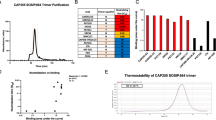Abstract
The antigenic polymorphism of HIV-1 is a major obstacle in developing an effective vaccine. Accordingly, we screened random peptide libraries (RPLs) displayed on phage with antibodies from HIV-infected individuals and identified an array of HIV-specific epitopes that behave as antigenic mimics of conformational epitopes of gp120 and gp41 proteins. We report that the selected epitopes are shared by a collection of HIV-1 isolates of clades A–F. The phage-borne epitopes are immunogenic in rhesus macaques, where they elicit envelope-specific antibody responses. Upon intravenous challenge with 60 MID50 of pathogenic SHIV-89.6PD, all monkeys became infected; however, in contrast to the naive and mock-immunized monkeys, four of five mimotope-immunized monkeys experienced lower levels of peak viremia, followed by viral set points of undetectable or transient levels of viremia and a mild decline of CD4+ T cells, and were protected from progression to AIDS-like illness. These results provide a new approach to the design of broadly protective HIV-1 vaccines.
This is a preview of subscription content, access via your institution
Access options
Subscribe to this journal
Receive 12 print issues and online access
$259.00 per year
only $21.58 per issue
Buy this article
- Purchase on SpringerLink
- Instant access to full article PDF
Prices may be subject to local taxes which are calculated during checkout



Similar content being viewed by others
References
Emini, E.A. et al. Prevention of HIV-1 infection in chimpanzees by gp120 V3 domain–specific monoclonal antibody. Nature 355, 728–730 (1992).
Shibata, R. et al. Neutralizing antibody directed against the HIV-1 envelope glycoprotein can completely block HIV-1/SIV chimeric virus infections of macaque monkeys. Nature Med. 5, 204–210 (1999).
Mascola, J.R. et al. Protection of macaques against vaginal transmission of a pathogenic HIV-1/SIV chimeric virus by passive infusion of neutralizing antibodies. Nature Med. 6, 207–210 (2000).
Baba, T.W. et al. Human neutralizing monoclonal antibodies of the IgG1 subtype protect against mucosal simian-human immunodeficiency virus infection. Nature Med. 6, 200–206 (2000).
Nabel, G.J. & Sullivan, N.J. Clinical implications of basic research: antibodies and resistance to natural HIV infection. N. Engl. J. Med. 343, 1263–1265 (2000).
Kuiken, C. et al. Human retroviruses and AIDS. Theoretical Biology and Biophysics, 1–789 (Los Alamos National Laboratory Press, Los Alamos, New Mexico, 1999).
Moore, J.P. & Sodroski, J. Antibody cross-competition analysis of the human immunodeficiency virus type 1 gp120 exterior envelope glycoprotein. J. Virol. 70, 1863–1872 (1996).
Weng, Y. & Weiss, C.D. Mutational analysis of residues in the coiled-coil domain of human immunodeficiency virus type 1 transmembrane protein gp41. J. Virol. 72, 9676–9682 (1998).
Parren, P.W., Moore, J.P., Burton, D.R. & Sattentau, Q.J. The neutralizing antibody response to HIV-1: viral evasion and escape from humoral immunity. AIDS 13 (Suppl A), S137–S162 (1999).
Simon, F. et al. Identification of a new human immunodeficiency virus type 1 distinct from group M and group O. Nature Med. 4, 1032–1037 (1998).
Kumar, A. et al. Evaluation of immune responses induced by HIV-1 gp120 in rhesus macaques: effect of vaccination on challenge with pathogenic strains of homologous and heterologous simian human immunodeficiency viruses. Virology 274, 149–164 (2000).
Connor, R.I. et al. Immunological and virological analyses of persons infected by human immunodeficiency virus type 1 while participating in trials of recombinant gp120 subunit vaccines. J. Virol. 72, 1552–1576 (1998).
Bures, R. et al. Immunization with recombinant canarypox vectors expressing membrane-anchored glycoprotein 120 followed by glycoprotein 160 boosting fails to generate antibodies that neutralize R5 primary isolates of human immunodeficiency virus type 1. AIDS Res. Hum. Retroviruses 16, 2019–2035 (2000).
Cortese, R. et al. Selection of biologically active peptides by phage display of random peptide libraries. Curr. Opin. Biotechnol. 7, 616–621 (1996).
Phalipon, A. et al. Induction of anti-carbohydrate antibodies by phage library–selected peptide mimics. Eur. J. Immunol. 27, 2620–2625 (1997).
Reitter, J.N., Means, R.E. & Desrosiers, R.C. A role for carbohydrates in immune evasion in AIDS. Nature Med. 4, 679–684 (1998).
Scala, G. et al. Selection of HIV-specific immunogenic epitopes by screening random peptide libraries with HIV-1–positive sera. J. Immunol. 162, 6155–6161 (1999).
Greenwood, J., Willis, A.E. & Perham, R.N. Multiple display of foreign peptides on a filamentous bacteriophage. Peptides from Plasmodium falciparum circumsporozoite protein as antigens. J. Mol. Biol. 220, 821–827 (1991).
di Marzo Veronese, F., Willis, A.E., Boyer-Thompson, C., Appella, E. & Perham, R.N. Structural mimicry and enhanced immunogenicity of peptide epitopes displayed on filamentous bacteriophage. The V3 loop of HIV-1 gp120. J. Mol. Biol. 243, 167–172 (1994).
Fogelman, I. et al. Evaluation of CD4+ T cell function in vivo in HIV-infected patients as measured by bacteriophage φX174 immunization. J. Infect. Dis. 182, 435–441 (2000).
De Berardinis, P. et al. Phage display of peptide epitopes from HIV-1 elicits strong cytolytic responses. Nature Biotechnol. 18, 873–876 (2000).
Zhu, T., Wang, N., Carr, A., Wolinsky, S. & Ho, D.D. Evidence for coinfection by multiple strains of human immunodeficiency virus type 1 subtype B in an acute seroconvertor. J. Virol. 69, 1324–1327 (1995).
Shapshak, P. et al. HIV-1 heterogeneity and cytokines. Neuropathogenesis. Adv. Exp. Med. Biol. 373, 225–238 (1995).
Kwong, P.D. et al. Structure of an HIV gp120 envelope glycoprotein in complex with the CD4 receptor and a neutralizing human antibody. Nature 393, 648–659 (1998).
Wyatt, R. et al. The antigenic structure of the HIV gp120 envelope glycoprotein. Nature 393, 705–711 (1998).
Vanden Haesevelde, M. et al. Genomic cloning and complete sequence analysis of a highly divergent African human immunodeficiency virus isolate. J. Virol. 68, 1586–1596 (1994).
Cotropia, J. et al. A human monoclonal antibody to HIV-1 gp41 with neutralizing activity against diverse laboratory isolates. J. Acquir. Immune Defic. Syndr. Hum. Retrovirol. 12, 221–232 (1996).
Zolla-Pazner, S., Gorny, M.K., Nyambi, P.N., VanCott, T.C. & Nadas, A. Immunotyping of human immunodeficiency virus type 1 (HIV): an approach to immunologic classification of HIV. J. Virol. 73, 4042–4051 (1999).
Reimann, K.A. et al. An env gene derived from a primary human immunodeficiency virus type 1 isolate confers high in vivo replicative capacity to a chimeric simian/human immunodeficiency virus in rhesus monkeys. J. Virol. 70, 3198–3206 (1996).
Karlsson, G.B. et al. Characterization of molecularly cloned simian–human immunodeficiency viruses causing rapid CD4+ lymphocyte depletion in rhesus monkeys. J. Virol. 71, 4218–4225 (1997).
Suryanarayana, K., Wiltrout, T.A., Vasquez, G.M., Hirsch, V.M. & Lifson, J.D. Plasma SIV RNA viral load determination by real-time quantification of product generation in reverse transcriptase–polymerase chain reaction. AIDS Res. Hum. Retroviruses 14, 183–189 (1998).
Masur, H. et al. CD4 counts as predictors of opportunistic pneumonias in human immunodeficiency virus (HIV) infection. Ann. Intern. Med. 111, 223–231 (1989).
Fahey, J.L. et al. The prognostic value of cellular and serologic markers in infection with human immunodeficiency virus type 1. N. Engl. J. Med. 322, 166–172 (1990).
Chun, T-W. et al. Suppression of HIV replication in the resting CD4+ T cell reservoir by autologous CD8+ T cells: Implications for the development of therapeutic strategies. Proc. Natl Acad. Sci. USA 98, 253–258 (2001).
Wasserstein, A.G. Membranous glomerulonephritis. J. Am. Soc. Nephrol. 8, 664–674 (1997).
Cho, M.W. et al. Polyvalent envelope glycoprotein vaccine elicits a broader neutralizing antibody response but is unable to provide sterilizing protection against heterologous simian/human immunodeficiency virus infection in pigtailed macaques. J. Virol. 75, 2224–2234 (2001).
Mellors, J.W. et al. Prognosis in HIV-1 infection predicted by the quantity of virus in plasma. Science 272, 1167–1170 (1996).
Garcia, P.M. et al. Maternal levels of plasma human immunodeficiency virus type 1 RNA and the risk of perinatal transmission. Women and Infants Transmission Study Group. N. Engl. J. Med. 341, 394–402 (1999).
Quinn, T.C. et al. Viral load and heterosexual transmission of human immunodeficiency virus type 1. Rakai Project Study Group. N. Engl. J. Med. 342, 921–929 (2000).
Barouch, D.H. et al. Control of viremia and prevention of clinical AIDS in rhesus monkeys by cytokine-augmented DNA vaccination. Science 290, 486–492 (2000).
Amara, R.R. et al. Control of a mucosal challenge and prevention of AIDS in rhesus macaques by a multiprotein DNA/MVA vaccine. Science 292, 69–74 (2001).
Stamatos, N.M. et al. Neutralizing antibodies from the sera of human immunodeficiency virus type 1–infected individuals bind to monomeric gp120 and oligomeric gp140. J. Virol. 72, 9656–9667 (1998).
Letwin, N.L. et al. Vaccine-elicited V3 loop–specific antibodies in rhesus monkeys and control. J. Virol. 75, 4165–4175 (2001).
Beyrer, C. et al. HIV type 1 subtypes in Malaysia, determined with serologic assays: 1992–1996. AIDS Res. Hum. Retroviruses 14, 1687–1691 (1998).
Acknowledgements
We thank R. Byrum for assisting with animal procedures; V. Hirsh and C. Brown for in situ hybridization; J. Hadelsberger for FACS analysis; B. Mathieson, M.A. Martin, C. Lane and J.R. Mascola for critical reading of the manuscript; Yichen Lu for supplying the SHIV-89.6PD seed stock; and P. Earl for the gift of go140-89.6. This work was supported in part by grants from AIRC, ISS. Telethon and MURST.
Author information
Authors and Affiliations
Corresponding author
Rights and permissions
About this article
Cite this article
Chen, X., Scala, G., Quinto, I. et al. Protection of rhesus macaques against disease progression from pathogenic SHIV-89.6PD by vaccination with phage-displayed HIV-1 epitopes. Nat Med 7, 1225–1231 (2001). https://doi.org/10.1038/nm1101-1225
Received:
Accepted:
Issue date:
DOI: https://doi.org/10.1038/nm1101-1225
This article is cited by
-
Biological evaluation of mimetic peptides as active molecules for a new and simple skin test in an animal model
Parasitology Research (2019)
-
Phage display as a promising approach for vaccine development
Journal of Biomedical Science (2016)
-
The aftermath of the Merck's HIV vaccine trial
Retrovirology (2008)
-
Prospects for an AIDS vaccine
Nature Medicine (2004)
-
AIDS vaccine models: Challenging challenge viruses
Nature Medicine (2002)



